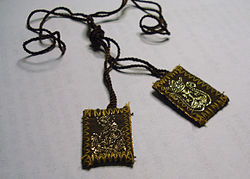The topic of this article may not meet Wikipedia's general notability guideline .(September 2022) |
The Scapular of the Sacred Hearts of Jesus and Mary (The Scapular of the Most Sacred Heart of Jesus in Agony and of the Most Loving and Sorrowful Heart of Mary) is a Catholic devotional scapular approved at the request of the Archbishop of Marseilles, by the Congregation of Rites in 1900. [1]
